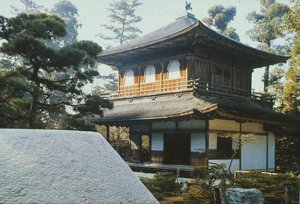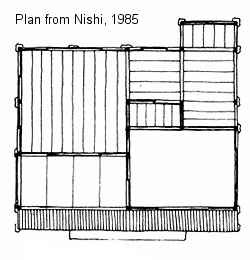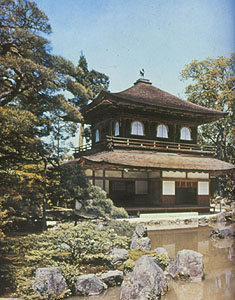Ginkaku-ji |
|
Located
east of the Kinkaku-ji in the Higashiyama mountains of Kyoto, the
Ginkaku-ji, or Silver Pavilion, appears similar to its predecessor at
first glance, but in fact offers a very different view of the architecture
of the Muromachi period. The pavilion was completed in 1484, about a hundred years after the
completion of the Kinkaku-ji. It was built for the 8th Ashikaga shogun, Yoshimasa, the
grandson of Yoshimitsu the patron for the Kinkaku-ji. The purposes for
building the pavilions were the same: to provide a
pleasant retirement villa for the patrons and to provide a place for their
own personal worship towards Buddha. In 1490, after the death of Yoshimasa,
the pavilion became part of a large Zen temple complex called the Jisho-ji.
However,
because of civil unrest throughout the country and in Kyoto, only two structures
remain today While their uses were virtually the same, the Ginkaku-ji displays a slightly different architectural style than that of the Kinkaku-ji. While the Golden Pavilion exhibits the use of the Shinden-Zukuri style, the Silver Pavilion uses the more recently developed Shoin style plan. The first floor, called the Shinkuden, or Hall of Emptied Mind, uses a combination of series of smaller spaces divided by wood and paper screens. The screens can be opened or shut, depending on how much space is needed or the purpose of the space. The first floor also contain images of Jizo, or the protector of children. The second floor has the same name as the Kinkaku-ji: Chouonkaku or Hall of Roaring Waves and also serves a similar purpose. It contains an image of the Kannon, one of the important Buddhist deities, and thus is also often referred to as the Kannon-hall. This gilded image of the Kannon is set against a black lacquered background. The plan of the second floor is influenced by Zen architecture as evident of the Kara style bracketing, and the protrusions of enclosed shelves inside the space in addition to protruding alter space for the Kannon. It is believed that the Silver Pavilion was to be leafed in silver much like the Golden Pavilion was leafed with gold, but for one reason or another, the pavilion has never been gilded. However, the building still has a wonderful elegance without the silver leafing, which is enhanced by the pond and landscape that surrounds the building. Supposedly once large enough for pleasure boating, the pond was heavily influenced by the garden designed by Muso Soseki for the Saiho-ji temple. The landscaping surrounding the Ginkaku-ji, became the backdrop for Yoshimasa and his many tea ceremonies and No plays that were held at his villa.
Kinkaku-ji
|

 .
.